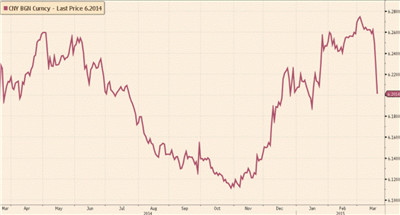Just weeks after everyone seemed to agree that China's renminbi will depreciate this year, it's heading back up again.
就在所有人似乎都认定人民币今年将会贬值的几周后,人民币汇率正再度回升。
The currency has jumped half a per cent today — its biggest move since March 24, 2014 — to 6.199, its best valuation against the dollar since January 16.
人民币兑美元汇率周四上涨0.5个百分点,至1美元兑6.199元人民币。这是自2014年5月24日以来的最高单日涨幅,让人民币汇率升至1月16日以来最高水平。

China's renminbi had its best day of 2015 on Wednesday, but policymakers appear to want to see the currency be worth even more.
人民币汇率周三的表现为2015年来最佳,但决策者似乎希望看到人民币汇率上涨更多。
"The volatility in USDCNY is impressive and speaks to the new trading regime that Chinese policymakers have been successful in encouraging," said Sacha Tihanyi, currency strategist at Scotiabank.
丰业资本(Scotiabank)外汇策略师萨沙•泰汉伊(Sacha Tihanyi)表示:“人民币兑美元汇率的波动令人印象深刻,也证明中国决策者一直鼓励的新的交易机制是成功的。”
Beijing set the "fix" — the mid-rate the around which the currency is allowed to trade — at 6.146 today, its lowest in three weeks. A lower fix means a higher renminbi and today it was lowered 16 basis points, the biggest downward move since February 6.
中国央行周四将人民币汇率中间价定在6.146美元,为3周来最低。中间价下浮意味着人民币汇率上涨。
The People's Bank of China has been guiding the currency towards a higher valuation since the renminbi hit a 28-month low at the end of February.
自人民币汇率2月底触及28个月低点以来,中国央行(PBoC)一直在引导汇率走高。
The depreciation earlier in the year made intuitive sense: as the economy slows down and its exports are hurt by the surging US dollar (which the renminbi is pegged to), a devaluation in the currency would help with easing efforts.
今年早些时候,由于中国经济放缓,同时出口受到美元汇率飙升的冲击,在北京出台宽松政策之际,人民币贬值将对经济有所助益。
This was certainly the line of thinking common among analysts. As noted in the FT last week, a recent survey by Société Générale failed to find anyone who thought the renminbi would rise against the dollar in the coming 12 months, while 42 per cent of respondents believed the PBoC would "actively seek depreciation" of the currency in response to declines in the yen and the euro.
这也是分析人士此前的普遍看法。正如英国《金融时报》上周指出的那样,法国兴业银行(Société Générale)最近的一项调查发现,没有人认为未来12个月人民币兑美元汇率将上涨,而42%的受访者认为,中国央行将“积极寻求贬值”以应对日元和欧元汇率下跌。
Instead, the currency is up 0.49 per cent today, following a 0.32 per cent climb yesterday and a 0.2 per cent move up on Tuesday. For many currencies those are tiny moves; for the tightly-controlled renminbi, they are huge (se chart).
人民币兑美元汇率今日上涨0.49%,周三和周二分别上涨0.32%和0.2%。对于很多货币而言,这些波动浮动很小;但对于受到严格管制的人民币而言,这是巨幅波动(见下图)。
Mr Tihanyi said today's move simply shows the PBoC reacting to overnight gains in other currencies. The US dollar index slumped more than 2 per cent against a range of rivals, so the PBoC followed suit.
泰汉伊表示,周四的举措只是表明央行正对其他货币汇率前一夜的上涨做出反应。美元兑其他一揽子货币指数前一夜下跌逾2%,因此中国央行也相应采取措施。
"It's very much about the dollar, it's all driven by the Fed, he said.
他表示:“这在很大程度上与美元有关,都是由美联储(Fed)推动的。”
But more broadly, Beijing is still clamping down on speculative bets about the currency's direction, to create more uncertainty, Mr Tihanyi said. The PBoC's main goal is to increase flexibility in the forex market and normalise the currency.
但泰汉伊表示,更广泛地来说,中国仍在打击押注人民币汇率走向以造成更多不确定性的投机活动。中国央行的主要目标是加大外汇市场的灵活性,让人民币汇率走向正常化。
Last year, the PBoC deliberately pushed the renminbi lower in "an engineered squeeze" to spook those who had made one-way bets on the currency, Mr Tihanyi said. This year the PBoC has stepped back, but with the consensus in recent weeks expecting the currency to fall, policymakers have been pushing it the other way.
泰汉伊表示,去年,中国央行曾有意推低人民币汇率,以吓退那些单方面押注于人民币升值的投机者。今年,中国央行减少了干预,但在最近几周市场达成共识预测人民币将贬值时,中国决策者再次将人民币汇率推向相反方向。


